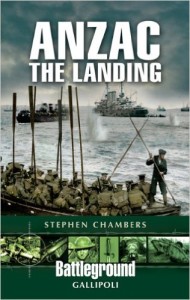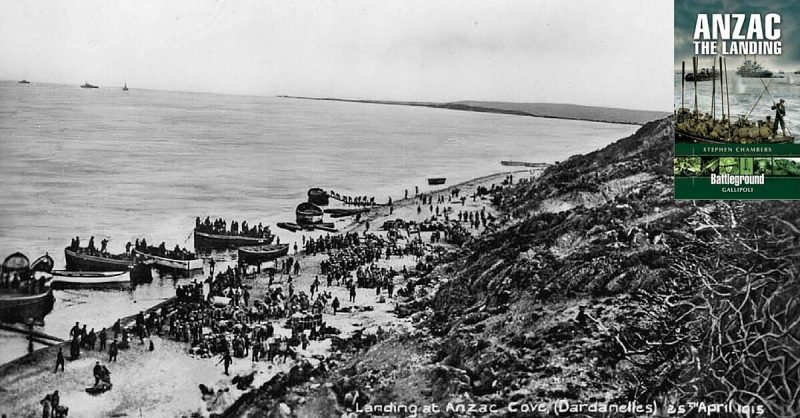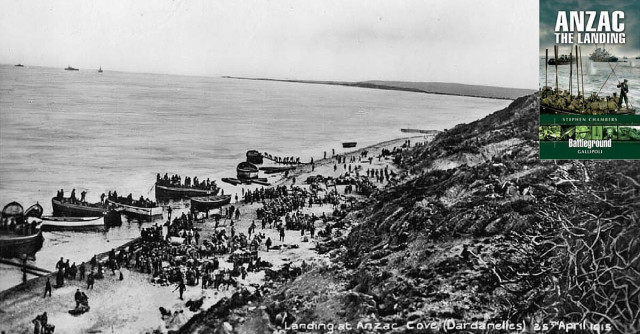This is one of Pen & Sword’s hugely popular Battleground series and the fact that this book is in its second print run is testimony to the series’ appeal. Stephen Chambers has set out to chronicle the Anzac Landing and operations immediately afterwards, while providing a useful and handy guide for the modern day visitor to the battlefield.
Gallipoli still arouses a huge amount of emotion and the Anzac landings on 25 April 1915, as part of a general an Anglo-who French amphibious operation, are no exception. Troops of the semi-trained Australian and New Zealand Army Corps were tasked with a phenomenally complex mission, a night time amphibious landing on a hostile coast line with ambitious objectives.
Landing on the wrong beach the operation failed to achieve most of its objectives. The swift push inland was defeated by fierce Turkish defence and counter-attack during which Mustafa Kemal famously ordered his troops to die defending against the attackers. The Anzacs held onto a beach head and perimeter that they ultimately could not break out of.
New Zealander Christopher Pugsley wrote in his book Gallipoli (Oratia Media and Pen & Sword, 2014) that the Anzacs were defeated by geography as much as by the Turks and Stephen Chambers makes that point early on in the text. True, the ground is rough and difficult to traverse, the flora is sharp and pointy but nonetheless the Turks were doughty fighters and not the ‘push over’ that some of the British and French planners had thought. Also, some of the officers, ageing ‘dugouts’ or often young and inexperienced as the rank and file, left a good deal to be desired and made many mistakes.
Despite the attempts to break out and push on, the Turks resisted the Anzac attacks. It has to be said that the story was very much the same for the British Empire and French troops who were similarly held by the Turks. The Anzacs’ task became one of grimly defending against Turkish attacks and the stuff of legends had been born. The stories of the contest between ‘Johnny’ Turk (as Turkish soldiers were called) and the famous ‘Diggers’ and ‘Fern Leaves’ (as the New Zealanders were known in 1915), are many and varied and Stephen Chambers brings their exploits in the early days of the campaign to life.
One cannot fail to have great sympathy for these semi-trained boys, many of whom were recent immigrants and who came from all walks of life, as they were thrown into a desperate battle for survival.
Research into the battles and campaigns of the Great War is going on all of the time and opinions and theories change as new information comes to light and new people undertake the research. The debate about all aspects of the Great War is alive and well (and sometimes irritating) and goes on across the globe. The Gallipoli campaign is no exception and as stated earlier it arouses many emotions and strong views, so well done to Stephen Chambers for grasping the nettle and writing this very useful and informative work.
The book is liberally and well illustrated with modern and contemporary photos, sketches and clear maps. Biographies of individuals have been inserted into the text and help to personalise the story and chapter nine deals with two suggested tours of the area that are pertinent to the initial landings. The book contains tourist and travel information, an excellent bibliography, a useful index and a comprehensive Order of Battle for both sides. There are good descriptions of the terrain and local flora which still does have a bearing on moving around the area and brought back some painful memories for me!
Steve Chambers had done a fine job of telling the tale of the Anzac Landing and I have thoroughly enjoyed reading his book. If you are interested in Gallipoli this book should be on your bookshelf. If you are going to Gallipoli you will have to visit Anzac Cove, Ari Burnu, Plugge’s Plateau, Shrapnel Gully, Walker’s Ridge, the Daisy Patch, Monash Valley, Russell’s Top.
Therefore, you should purchase this book and read it before you go and put it in your hand luggage and take it with you. It will provide you with a concise history of the Anzac Landings and be a very useful battlefield guide as you walk around the area yourself. Recommended reading.
Reviewed by Dr Wayne Osborne for War History Online.

ANZAC – THE LANDING
By Stephen Chambers.
Pen & Sword Ltd, 2008. Re-printed 2015.
ISBN 978 1 84415 722 8

